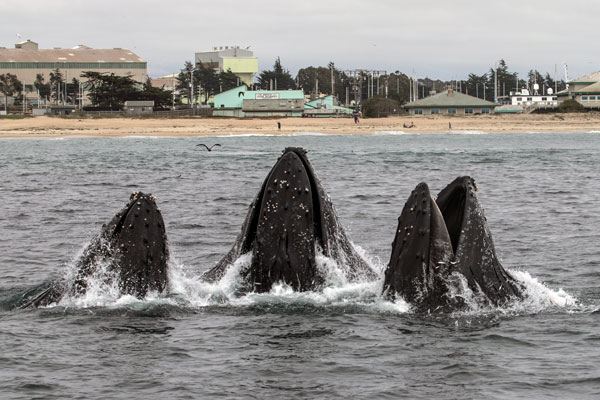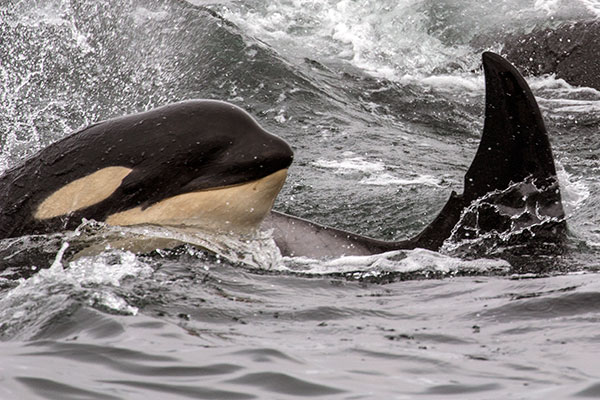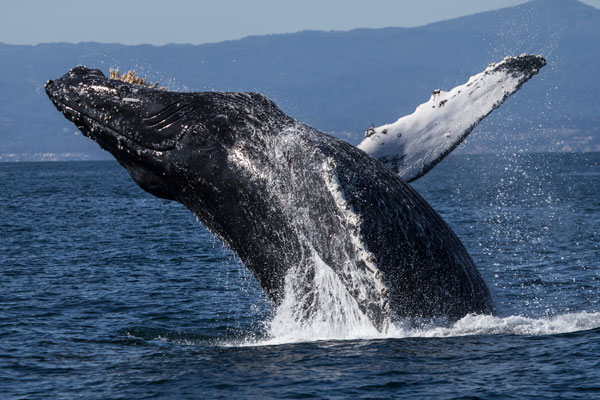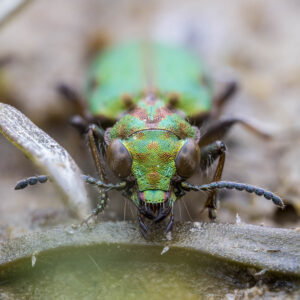
Marine biologist Dorris Welch gets to go whale watching four times a week. After all, it’s her business — and her life’s passion. The co-owner of Sanctuary Cruises, based out of Moss Landing on Monterey Bay, Dorris and her guests and crew have had the pleasure of seeing record numbers of humpback whales feeding unusually close to shore this year. We caught up with Dorris before she and her work and life partner Michael Sack, aka Captain Mike, headed out again on their 43-foot biodiesel-powered vessel to catch more spectacular sightings of these charismatic marine mammals.
Are you originally from the Bay Area?
Yes. I grew up in Sunnyvale. I learned to sail on Monterey Bay and San Francisco Bay at the age of ten, and spent a lot of time in Santa Cruz where we sailed.
What set you on your career path?
While I was studying marine biology at UC Santa Cruz (UCSC) in the late 1980s I got involved in marine mammal research and public interpretation at the university’s Long Marine Lab. Soon I became interested in spreading the word about marine mammals as my life’s work.
How did you end up owning and operating Sanctuary Cruises?
After many years of working in marine research education and conservation, I realized I was getting tired of working in an office instead of being out in the field, so I decided I needed to get back to my roots, which meant going out more on my sailboat again. And I began living aboard my boat, which was docked in Moss Landing. The prior owners of Sanctuary Cruises had a boat in the same harbor, and I just started volunteering as a naturalist on their trips, and ended up working for them for a year. They were planning on retiring, and before we knew it, they decided Mike and I were the right people to take over their business, which we did in 2011.
We’ve been seeing front-page stories on the incredible whale sightings inside Monterey Bay this summer. What’s going on?
It’s very unusual. It started early last fall (2013) right after Labor Day, when we had an incredible number of humpback whales coming right up into Moss Landing harbor, and they stayed late. The last ones we saw were on New Year’s Eve, very late in the season. Then in March of this year, they returned.

Are the whales behaving differently than usual, like approaching closer to the boat?
Yes, they are. We’ve had so many anchovies in the harbor that the whales are really putting on a show. Humpback whales are feeding in 25 feet of water and have actually entered the harbor mouth following the schools of fish. We see these spectacular surface-feeding episodes where the whales push the fish close to the surface and then come right up with their mouths open. It’s been quite spectacular — people have even been able to watch this from shore, and the whales come very close to the vessel.
We’re also seeing a lot of breaching this year – more rambunctious, frisky behavior. That means healthy, robust whales.
Are some species of whales more common than others this year?
Blue whales have been scarce this year. The last one we saw was in early July. We’ve seen very few this summer, and we believe it’s because we haven’t had enough krill to lure them in. The humpbacks, on the other hand, are quite numerous, possibly because they’re more diverse in their diets; they’ll eat fish like anchovies.
Why do you think we’re seeing this unusual influx of anchovies so close to shore?
We think it’s a combination of many different factors, including currents and tidal flow. One thing we know about anchovies is that they have long-term fluctuations in population. About every 50 years you have these peaks. I think we’re in one of those. As for the concentrations close to shore, almost in the surf zone, we have an hypothesis that it has to do with the tidal flow. Humpback whales are feeding in 25 feet of water and have actually entered the harbor mouth following schools of anchovies. The fish have been plentiful nearshore in shallow water and also at the head of the Monterey Submarine Canyon right at Moss Landing.
Do these humpback whales migrate?
Yes. California is their summer feeding ground, but in the winter they normally head south to Southern Mexico to breed. But an interesting thing has started to happen – we’re starting to see a few humpback whales stay here over the winter. It’s another indication that the population is increasing. The numbers are impressive. At any time we can see 20-25 on a 2-3 hour trip out of Moss Landing, and sometimes as many as 100.
Why do they migrate south to breed?
The theory is that the warmer, more tropical waters are a better place to have young that don’t have a blubber layer yet. But the problem is there’s not much food there. The whales are actually fasting while they’re down there. The female humpback loses up to 30% of her body weight in the process of migrating south, giving birth, and nursing her young.

Do you conduct any research in addition to giving tours?
We assist with some research: We actively collect krill samples for UCSC. We also do marine acoustic recordings. Sometimes the only way to discover what the animals are doing down there is by recording them.
How long do you think this abundance of humpbacks in Monterey Bay will last?
I can predict with some hope that humpbacks will stay in the Bay through Thanksgiving. Last year the number was huge and it had everything to do with the anchovies. That’s my hopeful prediction. In the fall we have a better chance of seeing the orcas – we generally have more orcas and dolphin—both Rissos and Pacific white-sided dolphins— and as we get into fall we’ll see more common dolphins that come in pods of 1000. We get the best ocean and atmospheric conditions in the fall; it’s the most beautiful season.
What about winter migrations?
In mid-December the grey whales’ migration begins – it goes from late December thru March. Even in the winter months, we’ll see some species of whales. We feel blessed to have healthy populations of whales and strong year-round whale watching — it’s a testament to the health of the Bay. All our great whales were hunted to endangered levels. We believe we’ve now returned to historic populations of both humpbacks and grey whales.
>> Learn more about whalewatching trips with Sanctuary Cruises at:
https://www.sanctuarycruises.com






